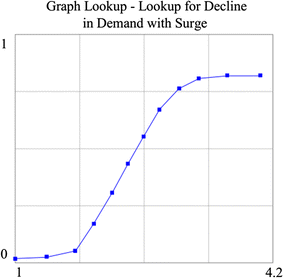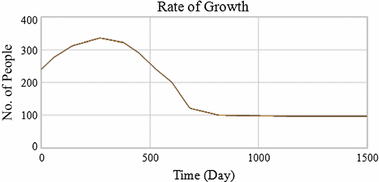Abstract
Unlike developed economies, developing economies lack surplus assets that have fueled the growth of sharing economy through various digital platforms. In this research, we build a system dynamics model of a ride sharing platform in a developing country that endogenizes the growth of the platform in the presence of stickiness of the asset provider, since platform growth can occur only through new investments in assets that have limited utility outside the platform. Our modeling approach enables capture of two-sided positive network externalities and the same-side negative externalities together in the same framework. Simulations illustrate that the pricing and incentive decisions taken by the platform to overcome the problem of initial asset unavailability have long-term consequences on various parameters of performance of the platform such as driver’s profits, platform revenues, and the level of prices of services.











Similar content being viewed by others
Notes
In a nightclub, if men gain more from interacting with women than vice versa, then we can expect that nightclubs will have a tendency to offer lower entry fees to women than to men.
Most cab aggregators also have a usage charge and fixed minimum charge (for x Kms). However, for simplicity we assume that this usage charge can be suitably adjusted into the per Km charge.
We do not lay emphasis on profits of the platform owner because there is lack of clarity on the costs associated with the platform management. The incentive costs may be treated as marketing costs essential to resolve the chicken and the egg problem and develop a market as is the case with most startups initially when the focus is on growth rather than actual profits because of the winner take all dynamics associated with Internet platforms.
In addition to the parameters, we also assume that there will be exit rates of the drivers based on the profits made by them. We model it similar to the entry rate of drivers.
References
Armstrong, M. 2006. Competition in two-sided markets. The Rand Journal of Economics 37 (3): 668–691.
Armstrong, M., and J. Wright. 2005. Two-Sided Markets, Competitive Bottlenecks and Exclusive Contracts. Economic Theory 32 (2): 353–380.
Bardhi, F., and G.M. Eckhardt. 2012. Access-based consumption: The case of car sharing: Table 1. Journal of Consumer Research 39 (4): 881–898.
Barlas, Y. 1996. Formal aspects of model validity and validation in system dynamics. System Dynamics Review 12 (3): 183–210.
Cachon, G.P., K.M. Daniels, and R. Lobel. 2017. The role of surge pricing on a service platform with self-scheduling capacity. Manufacturing & Service Operations Management 19 (3): 368–384.
Caillaud, B., and B. Jullien. 2003. Chicken & egg: Competition among intermediation service providers. RAND Journal of Economics Journal of Economics 34 (2): 309–328.
Castillo, J.C., Knoepfle, D., and Wyle, G. 2017 Surge pricing solves the wild goose chase. Proceedings of the 2017 ACM Conference on Economics and Computation. pp. 1–2.
Choudary, S.P. 2013. Why business models fail: Pipes vs. platforms. Wired. https://www.wired.com/insights/2013/10/why-business-models-fail-pipes-vs-platforms/.
Coyle, G. 1998. The practice of system dynamics: Milestones, lessons and ideas from 30 years experience. System Dynamics Review 14 (4): 343–365.
Cramer, J. and Krueger, A.B. 2015. Disruptive change in the taxi business: The case of Uber Judd Cramer and Alan B. Krueger. Princeton: Princeton University. https://doi.org/10.1257/aer.p20161002. Accessed 31 Dec 2015.
Einav, L., C. Farronato, and J. Levin. 2015. Peer-to-peer markets. SIEPR Discussion Paper 15 (29): 1–34.
Einav, L., C. Farronato, and J. Levin. 2016. Peer-to-peer markets. Annual Review of Economics 8 (1): 615–635.
Evans, D.S., and R. Schmalensee. 2016. The matchmakers: The new economics of multisided platforms. Boston: Harvard Business School Publishing.
Express, F. 2017. Uber, Ola cab drivers go on three-day strike in Guwahati after income plunges from Rs 75,000 to Rs 25,000 p.m., Financial Express. http://www.financialexpress.com/industry/uber-ola-cab-drivers-go-on-three-day-strike-in-guwahati-after-income-plunges-from-rs-75000-to-rs-25000-p-m/691080/. Accessed 6 Oct 2017.
Fang, Z., Huang, L. and Wierman, A. 2016. Prices and subsidies in the sharing economy http://arxiv.org/abs/1604.01627.
Forrester, J.W. 1996. Industrial dynamics. Waltham, MA: Pegasus Communication.
Gurvich, I., Lariviere, M. and Moreno, A. 2016. Operations in the on-demand economy: Staffing services with self-scheduling capacity. Ssrn, p. 27.
Hagiu, A. 2009. Two-sided platforms : Product variety and pricing structures. Journal of Economic and Management Strategy 18 (4): 1011–1043.
Hall, J., Kendrick, C. and Nosko, C. 2015. The effects of uber’ s surge pricing: A case study, mimeo.
Hinterhuber, A. 2004. Towards value-based pricing: An integrative framework for decision making. Industrial Marketing Management 33 (8): 765–778.
Jacob, J. and Roet-green, R. 2017. Ride solo or pool: The impact of sharing on optimal pricing of ride-sharing services.
Paul, B. 2017. Ola, Uber drivers go on strike in Bangalore as talks fail; one attempts suicide. Tech Circle. http://techcircle.vccircle.com/2017/02/16/ola-uber-drivers-go-on-strike-in-bangalore-as-talks-fail-one-attempts-suicide/. Accessed 26 Mar 2016.
Raysman, M. 2009. The economics of two-sided markets. Journal of Economic Perspectives 23 (3): 125–143.
Richardson, G.P. 1996. Modeling for management. Dartmouth: Aldershot.
Rifkin, J. 2016. Market share. RSA (Royal Society for the Encouragement of Arts, Manufactures and Commerce) Journal. f//medium.com/rsa-journal/market-share-8f028c7abcc7#.ml7z37v6u.
Rochet, J., and J. Tirole. 2003. Platform competition in two-sided markets. Journal of the European Economic Association 1 (4): 990–1029.
Rochet, J., and J. Tirole. 2006. Two-sided markets: A progress report. The Rand Journal of Economics 37 (3): 645–667.
Senge, P.M., and J.W. Forrester. 1980. Tests for building confidence in system dynamics models. System Dynamics, TIMS Studies in Management Sciences 14: 209–228.
Shah, A. 2017. Uber reviews India leasing scheme as driver incomes drop. Reuters. http://www.reuters.com/article/us-uber-tech-india-analysis-idUSKBN16V04Z.
Sundararajan, A. 2016. The sharing economy: The end of employment and the rise of crowd-based capitalism. https://books.google.com/books?id=F-iEjgEACAAJ&pgis=1.
Vlachos, D., P. Georgiadis, and E. Iakovou. 2007. A system dynamics model for dynamic capacity planning of remanufacturing in closed-loop supply chains. Computers & Operations Research 34 (2): 367–394.
Author information
Authors and Affiliations
Corresponding author
Appendix
Appendix
-
1.
Lookup for decline in demand as percentage of consumer demand for different surge prices on the platform

-
2.
Lookup for consumer growth rate

Rights and permissions
About this article
Cite this article
Gupta, A., Saha, B. & Banerjee, P. Pricing decisions of car aggregation platforms in sharing economy: a developing economy perspective. J Revenue Pricing Manag 17, 341–355 (2018). https://doi.org/10.1057/s41272-018-0145-1
Received:
Accepted:
Published:
Issue Date:
DOI: https://doi.org/10.1057/s41272-018-0145-1






